Verticordia carinata, commonly known as pea-shaped featherflower or Stirling Range featherflower, is a flowering plant in the myrtle family, Myrtaceae and is endemic to Western Australia. It is an erect, spindly shrub with small, well-spaced leaves and pink and red flowers. It is a rarely seen plant, not known between its description in 1849 and its rediscovery in 1990.
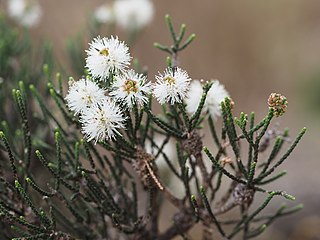
Melaleuca thyoides, commonly known as salt lake honey-myrtle is a plant in the myrtle family, Myrtaceae and is endemic to the south-west of Western Australia. It is an erect shrub with grey, papery or fibrous bark and very small, overlapping leaves on thin branchlets. It is a salt tolerant species often found on the edges of salt lakes.

Thryptomene mucronulata is a species of flowering plant in the family Myrtaceae and is endemic to Western Australia. It is an erect shrub with upward-pointing, overlapping, egg-shaped leaves with the narrower end towards the base and pink flowers with five petals and ten stamens.

Leucopogon gibbosus is a species of flowering plant in the heath family Ericaceae and is endemic to the south-west of Western Australia. It is a shrub with more or less round leaves and spikes of tube-shaped white flowers on the ends of branches and in leaf axils.
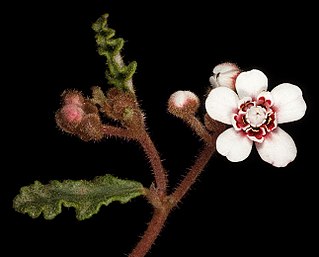
Androcalva pulchella is a species of flowering plant in the family Malvaceae and is endemic to the south-west of Western Australia. It is a small shrub with egg-shaped, elliptic or oblong leaves, the edges wavy, lobed or toothed, and clusters of two to seven white and deep pink flowers.
Conostephium drummondii is a species of flowering plant in the family Ericaceae and is endemic to the south-west of Western Australia. It is a slender, erect or spreading shrub that typically grows to a height of 0.3–1.5 m. It is a variable species with multi-coloured flowers from March to July or from November to December.
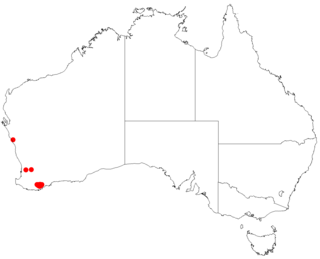
Leucopogon atherolepis is a species of flowering plant in the family Ericaceae and is endemic to the south-west of Western Australia. It is an erect shrub with linear leaves and white, tube-shaped flowers.

Leucopogon compactus is a species of flowering plant in the heath family Ericaceae and is endemic to the south of Western Australia. It is an erect shrub with oblong leaves and dense clusters of white, tube-shaped flowers.

Leucopogon cuneifolius is a species of flowering plant in the heath family Ericaceae and is endemic to Western Australia. It is an erect, bushy shrub that typically grows to a height of 0.2–1.5 m. Its leaves are egg-shaped to lance-shaped with the narrower end towards the base, about 6 mm (0.24 in) long with a distinct petiole. Up to 3 flowers are borne in upper leaf axils on a short peduncle, with small bracts and bracteoles at the base. The sepals are about 3 mm (0.12 in) long and the petals about 5 mm (0.20 in) long, the petal lobes much shorter than the petal tube.
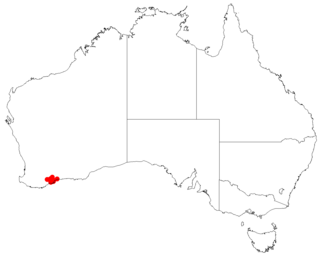
Leucopogon decussatus is a species of flowering plant in the heath family Ericaceae and is endemic to the south-west of Western Australia. It is an erect shrub that typically grows to a height of about 40 cm (16 in). It was first formally described in 1859 by Sergei Sergeyevich Sheglejev in the Bulletin de la Société impériale des naturalistes de Moscou. The specific epithet (decussatus) means "decussate".

Mirbelia subcordata is a species of flowering plant in the family Fabaceae and is endemic to the south-west of Western Australia. It is an erect, spreading shrub with egg-shaped to lance-shaped leaves and yellow or orange and red flowers.

Thomasia brachystachys is a species of flowering plant in the family Malvaceae and is endemic to the Southwest Australia south-west of Western Australia. It is an open, erect shrub with egg-shaped to heart-shaped leaves and pink to mauve flowers.

Leucopogon gilbertii is a species of flowering plant in the heath family Ericaceae and is endemic to the south-west of Western Australia. It is a slender shrub with linear to lance-shaped leaves and spikes of tube-shaped white flowers on the ends of branches and in leaf axils.

Leucopogon gnaphalioides is a species of flowering plant in the heath family Ericaceae and is endemic to the south-west of Western Australia. It is a slender or sprawling shrub with crowded egg-shaped to lance-shaped leaves and spikes of tube-shaped white flowers on the ends of branches and in upper leaf axils.

Leucopogon lasiophyllus is a species of flowering plant in the heath family Ericaceae and is endemic to the south-west of Western Australia. It is an erect shrub with linear to lance-shaped leaves and small, dense spikes of tube-shaped white flowers on the ends of branches and in leaf axils.

Leucopogon lasiostachyus is a species of flowering plant in the heath family Ericaceae and is endemic to the south-west of Western Australia. It is an erect shrub with egg-shaped to lance-shaped leaves and dense, cylindrical spikes of tube-shaped white flowers on the ends of branches and in leaf axils.
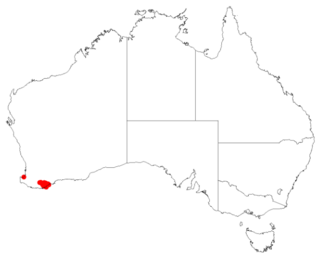
Leucopogon penicillatus is a species of flowering plant in the heath family Ericaceae and is endemic to the south-west of Western Australia. It is an slender, erect, spreading shrub with egg-shaped to narrowly triangular leaves and white, bell-shaped, bearded flowers arranged in groups of between 3 and 13.
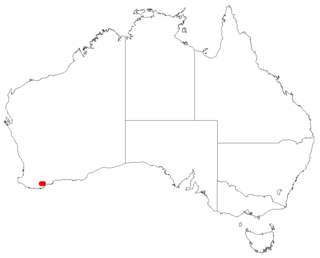
Leucopogon psilopus is a species of flowering plant in the heath family Ericaceae and is endemic to the Stirling Range in the south-west of Western Australia. The species was first formally described in 1859 by Sergei Sergeyevich Sheglejev in the Bulletin de la Société impériale des naturalistes de Moscou from specimens collected by James Drummond. It is listed as "Priority Two" by the Western Australian Government Department of Biodiversity, Conservation and Attractions, meaning that it is poorly known and from only one or a few locations. The specific epithet (psilopus) means "glabrous foot", probably referring to the pedicels.

Guichenotia angustifolia is a species of flowering plant in the family Malvaceae and is endemic to the south-west of Western Australia. It is an erect, prostrate or climbing shrub with hairy young growth, hairy, oblong to linear leaves and pink to mauve flowers.
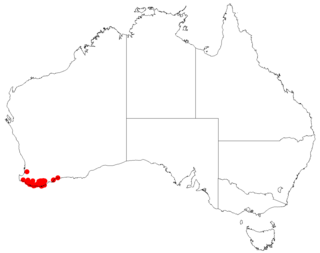
Leucopogon unilateralis is a species of flowering plant in the heath family Ericaceae and is endemic to the south-west of Western Australia. It is a shrub with oblong leaves and spikes of white, tube-shaped flowers arranged in small groups on the ends of branches and in upper leaf axils.


















